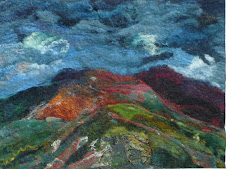Kev, a fellow member of the members of the Online guild of Weavers Spinners and Dyers, sent me some of his own weld extract which he had made himself, I am not sure when but probably about 18 months ago. Here is his website with the information on how to do it. A couple of weeks getting ready for a couple of big workshops I needed some greens in a bit of hurry and realised I had still got Kev's extract. You know what it is like when someone sends you something a bit special you put it on one side to use for something special. Then, months later, when you are tidying up you find it again. So this time I thought I will use it instead of waiting for this mythical special event!
He had sent me a small pot of the weld extract- but did I weigh it -did I heck :( . I tipped the small hard dull yellowy brown pieces ( probably about 20g or so) into a small jug and poured over hot water. If I had checked Kev's website I would have seen he said to dissolve it in ammonia but dissolving it in hot water worked well although it took half an hour or so. I poured the resulting liquid into a slow cooker, topped up with water and added 200g of merino tops mordanted in 8%alum 7%cream of tartar. See here for more about mordanting .
The fibres came out a bright yellow but I added a drop of ammonia-if I do not when the wool used in felting the fibres go a bright floresecent yellow with the pH of the soap.
 rinsed the fibres, partially dried them and then
rinsed the fibres, partially dried them and then immersed into an indigo vat . Look at the absolutely gorgeous green in the top right of the top photo.
immersed into an indigo vat . Look at the absolutely gorgeous green in the top right of the top photo.Altogether the weld extract dyed 600g of merino tops in strong to pale yellow and overdyed with indigo I got some yummy greens .
Thank you Kev - this was infinitely better than attacking my pile of dried weld which needs to be chopped up outside as it make such a mess.



























Gorgeous colours Helen - are you going to try Kev's method yourself with this summer's crop? Or could you use it when you finally get round to chopping what you have?
ReplyDeleteDeb
What beautiful colours Helen - Im literally drooling ;o)
ReplyDeleteI didnt know that soap could cause a colour change, very interesting!
Nice colours, and I too, didn't realize that the felting process with certain soap would change colour, as I am felting a lots these days, this was much needed info...thanks Helen
ReplyDeleteHi Debbie I tried it last year and got a tiny bit full of seeds, so need to work on technique!
ReplyDeleteGad you all like the colour as such as I do.!
Hi Helen, in the beginning you wrote my thoughts exactly:)
ReplyDeleteNice weld colors, I have read Kevins pages many times but somehow missed the part to making the extraction for yellow, in the winter it would be very handy to have the extraction ready and not needing to boil the plants.
Best wishes to you:)
I used weld on a knitted wool scarf and got what I call "neon yellow" not exactly the toned down natural dye color I was looking for,another gal then dipped her yellow into the indigo pot and got a lovely olivey deep green.
ReplyDeleteHi Lorna the colour you get from weld can surprise some people who refuse to believe it is natural colour!
ReplyDeleteWhat wonderful strong colours. I am always amazed by other peoples gorgeous yellows from weld. I want to follow up what I learnt in the Online Guild discussion and use weld in a dyebath where the water that has less iron than occurs in our tap water.
ReplyDeleteHi Dorothy adding ammonia helps to brighten the colour but if you have iron in your water you will get greenish yellows. However when the weld is picked and which part is used will also hvae a effect. Contrary towaht soem dye books say weld should be picked as it goes into seed
ReplyDeleteI would like to use the top image as an example of Lincoln Green (weld, over dyed in woad, indigo same as woad for all practical purposes) for Wikipedia. Would you be so kind as to allow it's use?
ReplyDeleteA simple reply "I release the top image into the public domain" will suffice.
Thanks.